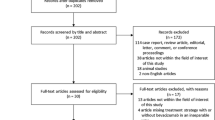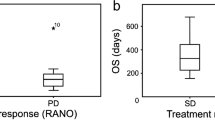Abstract
Bevacizumab, an anti-angiogenic agent, is FDA-approved for use in patients with recurrent glioblastoma multiforme (rGBM). The radiologic evaluation of tumor response to bevacizumab is complex and there is no validated method of monitoring tumor vascularity during therapy. We evaluated perfusion-weighted MR imaging (PWI) in our cohort of patients enrolled in the CABARET trial, which examined the effectiveness of bevacizumab with or without carboplatin in patients with rGBM. Pre-treatment and early follow-up (4- and 8-week) PWI were used to calculate relative cerebral blood volume (rCBV) histogram statistics of the contrast-enhancing and FLAIR hyperintense tumor volumes. A novel rCBV measurement (load) was developed to estimate the total volume of perfused tumor blood vessels. Changes in all rCBV measures were examined for correlations with progression-free (PFS) and overall survival (OS). All of our 15 patients enrolled in the CABARET trial were included. Median PFS and OS were 23 and 45 weeks respectively. Kaplan–Meier analysis of pre-treatment PWI revealed an 18 week reduction in median OS in patients with high tumor rCBV (p = 0.031). Changes in rCBV measures, especially load, correlated significantly with PFS and OS at both follow-up time-points. Patients with the greatest reduction in rCBVload by 8-weeks of therapy had a significantly increased median OS (30 weeks; p = 0.013). PWI may be of significant clinical utility in managing patients with rGBM, particularly those treated with anti-angiogenic agents such as bevacizumab. These findings need to be confirmed prospectively in larger studies.



Similar content being viewed by others
References
Cohen MH, Shen YL, Keegan P, Pazdur R (2009) FDA drug approval summary: bevacizumab (Avastin) as treatment of recurrent glioblastoma multiforme. Oncologist 14:1131–1138. doi:10.1634/theoncologist.2009-0121
Khasraw M, Simeonovic M, Grommes C (2012) Bevacizumab for the treatment of high-grade glioma. Expert Opin Biol Ther 12:1101–1111. doi:10.1517/14712598.2012.694422
Wen PY, Macdonald DR, Reardon DA et al (2010) Updated response assessment criteria for high-grade gliomas: response assessment in neuro-oncology working group. J Clin Oncol 28:1963–1972. doi:10.1200/JCO.2009.26.3541
Rüegg C, Meuwly J-Y, Driscoll R et al (2003) The quest for surrogate markers of angiogenesis: a paradigm for translational research in tumor angiogenesis and anti-angiogenesis trials. Curr Mol Med 3:673–691
Gossmann A, Helbich TH, Kuriyama N et al (2002) Dynamic contrast-enhanced magnetic resonance imaging as a surrogate marker of tumor response to anti-angiogenic therapy in a xenograft model of glioblastoma multiforme. J Magn Reson Imaging 15:233–240
Keunen O, Johansson M, Oudin A et al (2011) Anti-VEGF treatment reduces blood supply and increases tumor cell invasion in glioblastoma. Proc Natl Acad Sci 108:3749–3754. doi:10.1073/pnas.1014480108
Pechman KR, Donohoe DL, Bedekar DP et al (2011) Characterization of bevacizumab dose response relationship in U87 brain tumors using magnetic resonance imaging measures of enhancing tumor volume and relative cerebral blood volume. J Neurooncol 105:233–239. doi:10.1007/s11060-011-0591-8
Verhoeff JJC, Lavini C, van Linde ME et al (2010) Bevacizumab and dose-intense temozolomide in recurrent high-grade glioma. Ann Oncol 21:1723–1727. doi:10.1093/annonc/mdp591
Sawlani RN, Raizer J, Horowitz SW et al (2010) Glioblastoma: a method for predicting response to antiangiogenic chemotherapy by using MR perfusion imaging—pilot study. Radiology 255:622–628. doi:10.1148/radiol.10091341
Kreisl TN, Zhang W, Odia Y et al (2011) A phase II trial of single-agent bevacizumab in patients with recurrent anaplastic glioma. Neuro-oncology 13:1143–1150. doi:10.1093/neuonc/nor091
Laviolette PS, Cohen AD, Prah MA et al (2013) Vascular change measured with independent component analysis of dynamic susceptibility contrast MRI predicts bevacizumab response in high-grade glioma. Neuro-oncology 15:442–450. doi:10.1093/neuonc/nos323
Paulson ES, Schmainda KM (2008) Comparison of dynamic susceptibility-weighted contrast-enhanced MR methods: recommendations for measuring relative cerebral blood volume in brain tumors. Radiology 249:601–613. doi:10.1148/radiol.2492071659
Therasse P, Arbuck SG, Eisenhauer EA et al (2000) New guidelines to evaluate the response to treatment in solid tumors. European Organization for Research and Treatment of Cancer, National Cancer Institute of the United States, National Cancer Institute of Canada. J Natl Cancer Inst 92:205–216
Galanis E, Buckner JC, Maurer MJ et al (2006) Validation of neuroradiologic response assessment in gliomas: measurement by RECIST, two-dimensional, computer-assisted tumor area, and computer-assisted tumor volume methods. Neuro-oncology 8:156–165. doi:10.1215/15228517-2005-005
Macdonald DR, Cascino TL, Schold SC, Cairncross JG (1990) Response criteria for phase II studies of supratentorial malignant glioma. J Clin Oncol 8:1277–1280
Wong ET, Hess KR, Gleason MJ et al (1999) Outcomes and prognostic factors in recurrent glioma patients enrolled onto phase II clinical trials. J Clin Oncol 17:2572–2578
Vredenburgh JJ, Desjardins A, Herndon JE et al (2007) Bevacizumab plus irinotecan in recurrent glioblastoma multiforme. J Clin Oncol 25:4722–4729. doi:10.1200/JCO.2007.12.2440
Reardon DA, Desjardins A, Vredenburgh JJ et al (2009) Metronomic chemotherapy with daily, oral etoposide plus bevacizumab for recurrent malignant glioma: a phase II study. Br J Cancer 101:1986–1994. doi:10.1038/sj.bjc.6605412
Sathornsumetee S, Desjardins A, Vredenburgh JJ et al (2010) Phase II trial of bevacizumab and erlotinib in patients with recurrent malignant glioma. Neuro-oncology 12:1300–1310. doi:10.1093/neuonc/noq099
Møller S, Grunnet K, Hansen S et al (2012) A phase II trial with bevacizumab and irinotecan for patients with primary brain tumors and progression after standard therapy. Acta Oncol 51:797–804. doi:10.3109/0284186X.2012.681063
Nagane M, Nishikawa R, Narita Y et al (2012) Phase II study of single-agent bevacizumab in Japanese patients with recurrent malignant glioma. Jpn J Clin Oncol 42:887–895. doi:10.1093/jjco/hys121
Tselikas L, Souillard-Scemama R, Naggara O et al (2015) Imaging of gliomas at 1.5 and 3 T—a comparative study. Neuro-oncology 17:895–900. doi:10.1093/neuonc/nou332
Acknowledgments
The authors wish to thank Luisa Barassi, Linda Garrett, Simon Salinas and Chris Steward for their assistance in this project.
Funding
The CABARET trial was conducted by The Cooperative Trials Group for Neuro-Oncology (COGNO), and was funded in part by Roche. This analysis was supported in part by funding received from The Brain Foundation, the Neurosurgical Society of Australasia, the Cure for Life Foundation, and the Royal Australasian College of Surgeons.
Author information
Authors and Affiliations
Corresponding author
Ethics declarations
Conflict of interest
The CABARET trial was funded in part by Roche. No other potential conflicts of interest regarding the submission of this manuscript have been identified by any of the authors.
Electronic supplementary material
Below is the link to the electronic supplementary material.
Rights and permissions
About this article
Cite this article
Bennett, I.E., Field, K.M., Hovens, C.M. et al. Early perfusion MRI predicts survival outcome in patients with recurrent glioblastoma treated with bevacizumab and carboplatin. J Neurooncol 131, 321–329 (2017). https://doi.org/10.1007/s11060-016-2300-0
Received:
Accepted:
Published:
Issue Date:
DOI: https://doi.org/10.1007/s11060-016-2300-0




